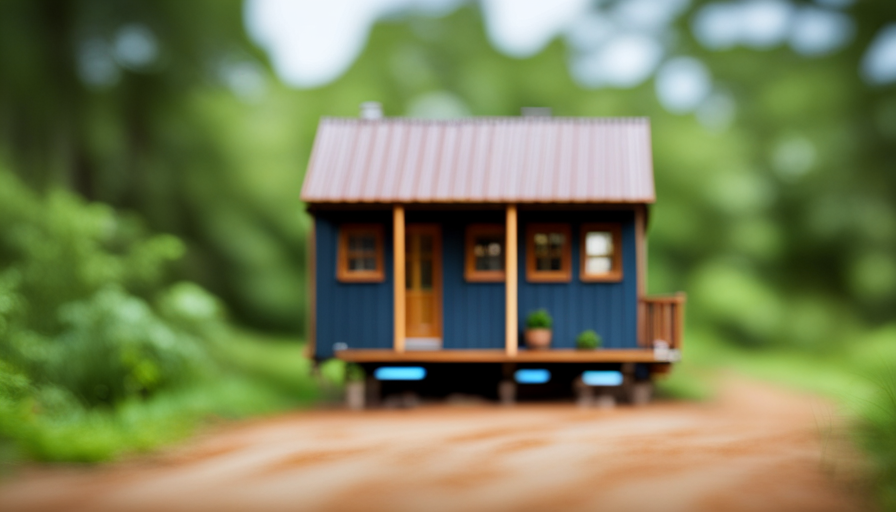So, you’ve made the decision to bid farewell to your beloved tiny home. Maybe you require more space and are looking to transition into a larger dwelling, or perhaps you’re seeking to further simplify your lifestyle. Whatever the reason may be, the thought of putting your tiny house back on the market can feel daunting. But fret not, as we are here to guide you through this process every step of the way.
In this article, we’ll provide you with a step-by-step guide on how to resell your tiny house successfully. From assessing its value and preparing it for sale, to determining the perfect selling price and finding potential buyers, we’ve got you covered. We’ll even delve into the legal and financial implications you should consider, as well as provide tips on how to ensure a smooth closing process.
So, if you’re ready to embark on this journey of reselling your tiny house, grab a pen and paper, and let’s get started!
Key Takeaways
- Assess the value of your tiny house before selling by researching market trends, getting a professional appraisal, and evaluating its condition, age, and unique features.
- Prepare your tiny house for sale by decluttering, deep cleaning, repairing damages, and touching up paint if necessary. Stage the house to showcase its potential to buyers.
- Upgrade the kitchen and bathroom, add fresh paint, new flooring, and updated lighting fixtures to increase the value of your tiny house. Also, inspect the structure for wear and tear and make necessary repairs.
- Determine the selling price of your tiny house based on its condition, location, and features. Research similar sold houses for market value and consider including unique features and upgrades for a higher price.
Assess the Value of Your Tiny House
Before you can resell your tiny house, it’s important to assess its value to determine how much you can potentially make from the sale. Assessing the market and understanding the pricing strategies are crucial steps in this process.
Start by researching the current market trends for tiny houses in your area. Look for similar listings and compare their prices to get an idea of the average selling price. Consider factors such as location, size, and amenities to determine how your tiny house compares to others on the market.
Next, take a closer look at your own tiny house. Evaluate its condition, age, and any unique features it may have. Be honest with yourself about its strengths and weaknesses. Consider getting a professional appraisal to get an accurate estimate of its value. Keep in mind that the value of a tiny house is subjective, and ultimately, it is worth what someone is willing to pay for it.
Once you have assessed the value of your tiny house, you can start preparing it for sale. Begin by decluttering and deep cleaning the space. Repair any damages and touch up the paint if necessary. Stage the tiny house to showcase its potential to potential buyers. By presenting your tiny house in the best possible light, you increase its chances of selling quickly and at a desirable price.
Prepare Your Tiny House for Sale
When preparing your tiny house for sale, it’s essential to start by cleaning and decluttering the space. Remove any personal items and excess furniture to create a clean and spacious environment that potential buyers can envision themselves living in.
Next, make necessary repairs and upgrades to ensure that your tiny house is in top condition. Fix any leaks, replace worn-out fixtures, and consider adding new features that’ll add value to your property.
Finally, stage your tiny house for showings by arranging furniture in a way that highlights the functionality and unique features of the space. Use neutral colors and minimal decor to create a welcoming and inviting atmosphere that’ll appeal to a wide range of buyers.
Clean and Declutter
To maximize your chances of a successful resale, it’s crucial to tidy up and get rid of any unnecessary clutter in your tiny house. Cleanliness tips and organizing strategies can make a big difference in attracting potential buyers. Here are four important things to focus on:
-
Deep clean every nook and cranny, from the floors to the ceilings, to ensure your tiny house sparkles.
-
Declutter by getting rid of any personal items or excessive furniture that might make the space feel cramped.
-
Organize your storage spaces, such as cabinets and closets, to showcase their full potential and demonstrate ample storage options.
-
Pay attention to details like wiping down windows, polishing fixtures, and making sure everything smells fresh.
By following these cleaning and decluttering tips, you’ll create an inviting atmosphere that appeals to buyers.
Now, let’s move on to the next section and discuss how to make necessary repairs and upgrades.
Make Necessary Repairs and Upgrades
Now, it’s time to tackle essential fixes and upgrades to enhance the appeal of your compact dwelling.
Tiny house renovation is all about maximizing resale value, so it’s crucial to focus on areas that potential buyers prioritize.
Start by inspecting the structure for any signs of wear and tear. Replace damaged siding, repair leaks, and ensure the roof is in good condition.
Upgrading the kitchen and bathroom can significantly increase the value of your tiny house. Consider installing energy-efficient appliances, modern fixtures, and attractive countertops. Don’t forget to address any plumbing or electrical issues that may arise during the process.
Additionally, fresh paint, new flooring, and updated lighting fixtures can make a big difference in the overall aesthetics.
By investing in these repairs and upgrades, you’re setting yourself up for a successful sale.
Transitioning to the next step, it’s time to stage your tiny house for showings.
Stage Your Tiny House for Showings
Transform your compact dwelling into a captivating showcase by expertly staging it for potential buyers. Staging your tiny house is crucial to highlight its unique features and create an inviting atmosphere that captivates buyers.
Here are three staging tips to help you showcase your tiny house:
-
Maximize Space: Utilize clever storage solutions to demonstrate the functionality of your tiny house. Show potential buyers how every nook and cranny can be used effectively.
-
Highlight Key Features: Draw attention to the standout features of your tiny house, such as a beautiful built-in bookshelf or a cozy sleeping loft. Use tasteful decor and lighting techniques to accentuate these elements.
-
Create an Outdoor Oasis: Enhance the appeal of your tiny house by creating an inviting outdoor space. Add some potted plants, comfortable seating, and ambient lighting to create a tranquil retreat.
By staging your tiny house with these tips, you’ll entice buyers to envision themselves living in your space. Once your tiny house is perfectly staged, it’s time to determine your selling price and move forward in the reselling process.
Determine Your Selling Price
Calculating the selling price of your tiny house involves considering factors such as the overall condition, location, and unique features it offers. To determine the right selling price, it’s important to develop a pricing strategy based on market analysis.
Start by researching similar tiny houses that have recently sold in your area. Look for houses that are comparable in terms of size, condition, and location. This will give you a sense of the market value and help you set a competitive price.
Next, take into account any unique features or upgrades that your tiny house may have. These can add value and justify a higher selling price. Consider factors such as energy-efficient appliances, custom-built furniture, or a unique design. These features can set your tiny house apart from others on the market and attract potential buyers.
Additionally, consider the overall condition of your tiny house. If it’s in excellent condition with minimal wear and tear, you may be able to ask for a higher price. On the other hand, if there are any repairs or maintenance issues that need to be addressed, you may need to adjust the price accordingly.
When determining your selling price, it’s important to be realistic and take into account the current market conditions. Remember, pricing your tiny house too high may deter potential buyers, while pricing it too low may lead to missed opportunities.
Once you have determined your selling price, you can move on to the next step – marketing your tiny house effectively.
Market Your Tiny House
With a well-executed marketing strategy, your tiny home will become a beacon, shining a light on its unique features and attracting eager buyers. To effectively market your tiny house, you need to employ a variety of marketing strategies that will maximize exposure and generate interest. One of the most powerful tools at your disposal is social media promotion. Utilize platforms such as Facebook, Instagram, and Twitter to showcase your tiny home’s charm, functionality, and eco-friendly features. Engage with your audience by posting high-quality photos, videos, and virtual tours. Create compelling captions that highlight the key selling points of your tiny home, such as its energy efficiency, space-saving design, and luxurious amenities.
Additionally, consider hosting open houses and participating in local home shows or tiny house events to reach a wider audience. Collaborate with real estate agents who specialize in tiny homes or small living spaces to tap into their network of potential buyers.
Finding potential buyers for your tiny house is the next crucial step in the reselling process. By effectively marketing your tiny home and utilizing social media promotion, you will attract interested buyers who are eager to own a unique and sustainable living space.
Find Potential Buyers
Now that you’ve successfully marketed your tiny house, it’s time to find potential buyers who are interested in purchasing it. This step is crucial in ensuring a successful resale of your tiny house.
To attract potential buyers, you need to implement effective advertising strategies that showcase the unique features and benefits of your tiny house. Utilize online platforms such as social media, real estate websites, and tiny house-specific forums to reach a wider audience.
Additionally, networking with tiny house communities can be a valuable resource in finding potential buyers. Attend tiny house events, join online communities, and engage in conversations with individuals who share a passion for tiny living. By connecting with like-minded individuals, you increase your chances of finding someone who’s specifically looking to buy a tiny house.
When transitioning into the subsequent section about negotiating and finalizing the sale, it’s important to remember that finding potential buyers is just the first step in the process. The next step is to negotiate and finalize the sale, ensuring that both parties are satisfied with the terms and conditions.
Negotiate and Finalize the Sale
Once you’ve found potential buyers who are interested in purchasing your charming abode, it’s time to dive into the exciting process of negotiating and finalizing the sale.
Negotiation strategies play a crucial role in ensuring a successful transaction, so it’s important to approach this stage with confidence and knowledge. Start by setting a competitive price for your tiny house based on its value and market trends. Be prepared to negotiate on the price, but also consider other factors that may be of value to the buyer, such as including certain furnishings or offering flexible payment options. This can give you an edge in negotiations and help close the deal.
During the negotiation process, don’t be afraid to make counteroffers or suggest alternative terms to meet both parties’ needs. It’s essential to maintain open communication and be willing to compromise to reach a mutually beneficial agreement.
Once the negotiation phase is complete, it’s time to finalize the sale. Ensure all necessary paperwork is in order, including the bill of sale, title transfer, and any other legal requirements specific to your location. Additionally, consider involving a real estate attorney to ensure a smooth closing process.
With the negotiation and sale finalized, it’s time to move onto the next step of ensuring a smooth closing process by taking care of the necessary paperwork and coordinating with the buyer’s financing institution.
Ensure a Smooth Closing Process
To ensure a smooth closing process for your charming abode, it’s important to take care of all the necessary paperwork and coordinate with the buyer’s financing institution. This will ensure that everything is in order and that the sale can proceed without any hiccups.
Here are some key steps to follow:
-
Gather all the required documents: Before the closing date, make sure you have all the necessary paperwork ready. This may include the title deed, bill of sale, and any other relevant documents required by your local jurisdiction.
-
Coordinate with the buyer’s financing institution: If the buyer’s obtaining a loan to purchase your tiny house, you’ll need to work closely with their lender. Make sure you provide all the requested documents and information promptly to avoid any delays.
-
Conduct a final walkthrough: Before the closing, it’s advisable to conduct a final walkthrough with the buyer. This’ll allow both parties to ensure that everything is in the expected condition and address any last-minute concerns.
By following these steps and ensuring that all the paperwork requirements are met, you can facilitate a smooth closing process for your tiny house. Once this is done, it’s important to consider the legal and financial implications of the sale to complete the reselling process seamlessly.
Consider Legal and Financial Implications
When reselling a tiny house, it’s crucial to consider the legal and financial implications involved.
First, you should thoroughly research the local zoning regulations and building codes to ensure that your tiny house meets all the necessary requirements.
Additionally, it’s highly advisable to consult with a real estate attorney or accountant who can provide expert guidance and advice throughout the process.
Finally, it’s important to understand your tax obligations and reporting requirements, as selling a tiny house may have tax implications that you need to be aware of and properly address.
Research Local Zoning Regulations and Building Codes
Before reselling a tiny house, make sure to thoroughly research the local zoning regulations and building codes in your area. This step is crucial to ensure that you comply with all the legal requirements and avoid any potential issues down the line.
Start by conducting a comprehensive research on the specific zoning laws that govern the area where your tiny house is located. Look into any restrictions or special permits that may be required for selling a tiny house.
Additionally, familiarize yourself with the building codes to ensure that your tiny house meets all the necessary safety and structural requirements. By understanding the local zoning regulations and building codes, you can confidently navigate through the process of reselling your tiny house.
Once you have this knowledge, consult with a real estate attorney or accountant to further guide you in the reselling process.
Consult with a Real Estate Attorney or Accountant
Consider reaching out to a real estate attorney or accountant who can provide valuable guidance on navigating the process of reselling your tiny home. These professionals have the expertise to help you understand the legal obligations and potential hurdles that may arise during the resale process.
Here are three key reasons why consulting with a real estate attorney or accountant is beneficial:
-
Expertise: These professionals have a deep understanding of real estate laws and regulations, ensuring that you are aware of any legal implications or restrictions when reselling your tiny home.
-
Protection: By seeking professional advice, you can protect yourself from any potential legal issues that may arise during the resale process, minimizing the risk of costly mistakes or disputes.
-
Financial Guidance: A real estate attorney or accountant can provide insights on tax obligations and reporting requirements associated with reselling your tiny home, helping you navigate this complex aspect of the process.
By consulting with these professionals, you can gain the knowledge and support necessary to successfully navigate the legal and financial aspects of reselling your tiny home. Understanding tax obligations and reporting requirements is another crucial step in the resale process.
Understand Tax Obligations and Reporting Requirements
Navigating the tax obligations and reporting requirements is a crucial aspect of reselling your tiny home, ensuring compliance and avoiding any potential issues. As a seller, it’s important to understand the tax implications of your tiny house sale. Depending on your specific situation, you may be eligible for certain tax deductions that can reduce your overall tax liability. Consult with a knowledgeable real estate attorney or accountant who can guide you through the process and help you identify any deductions you may be eligible for.
Additionally, it’s essential to have a clear understanding of the selling contracts involved in the transaction. These contracts outline the terms and conditions of the sale, including the purchase price, payment terms, and any contingencies. Make sure to review these contracts thoroughly and seek legal advice if needed to ensure that all aspects of the sale are properly documented and legally binding.
With a solid understanding of the tax obligations and proper documentation in place, you can now move on to the next step: preparing for the move.
Prepare for the Move
To get ready for the move, you gotta make sure all your belongings are secured and protected inside the tiny house. This is crucial to ensure that nothing gets damaged or lost during transportation. Here are some packing tips to help you out:
-
Use sturdy boxes and containers: Invest in high-quality boxes and containers that can withstand the rigors of the move. Make sure they’re properly sealed to prevent any items from falling out.
-
Wrap fragile items individually: Take extra care when packing delicate items such as glassware or electronics. Wrap ’em individually in bubble wrap or packing paper to provide cushioning and prevent breakage.
-
Label everything: Clearly label each box with its contents and the room it belongs to. This’ll make unpacking much easier and save you time in the long run.
-
Consider hiring professional movers: If you’re not confident in your own packing skills or simply don’t have the time, hiring professional movers can be a great option. They have the expertise and resources to handle the move efficiently and safely.
Once everything’s packed and ready to go, you can focus on the next steps, such as follow-up and support for the new owner.
Follow-Up and Support for the New Owner
Once everything is securely packed and ready to go, it’s important to provide ongoing support and guidance for the new owner of your tiny house. Selling a tiny house is not just about the transaction; it’s about ensuring the new owner has a smooth transition into their new home. To achieve this, offering follow-up services and post-sale assistance is crucial.
One way to provide support is by offering a comprehensive guidebook that includes all the necessary information about the tiny house. This guidebook can cover topics such as maintenance tips, troubleshooting common issues, and suggestions for customization. Additionally, you can include a list of trusted suppliers for any future repairs or upgrades the new owner may need.
Another way to offer assistance is by providing a warranty for the tiny house. This gives the new owner peace of mind, knowing that if any unexpected problems arise, they will be covered. Clearly outlining the warranty terms and conditions in the guidebook will ensure that the new owner is aware of their rights and responsibilities.
Furthermore, maintaining open lines of communication is essential. Encourage the new owner to reach out with any questions or concerns they may have, and be responsive in providing timely and helpful answers. This will foster a positive relationship and establish you as a trustworthy resource.
By offering follow-up services and post-sale assistance, you are not only ensuring the satisfaction of the new owner but also building a strong reputation as a reliable and supportive seller.
Frequently Asked Questions
What are some common legal and financial implications to consider when reselling a tiny house?
When it comes to reselling a tiny house, legal implications and financial considerations are not to be taken lightly. You might think it’s a piece of cake, but oh, how wrong you are!
Legal implications can include zoning regulations, building codes, and even potential disputes with neighbors.
Financially, you need to consider factors such as market demand, depreciation, and the costs of advertising and selling.
So, my dear friend, before you embark on this journey, make sure you’re well-prepared for the twists and turns that await you.
How can I ensure a smooth closing process when selling my tiny house?
To ensure a smooth closing process when selling your tiny house, there are a few key steps to follow.
First, gather all necessary documentation, including the title, bill of sale, and any permits or certifications. Make sure everything is accurate and up-to-date.
Next, communicate effectively with the buyer and their representatives to address any questions or concerns promptly.
Finally, hire a reliable closing agent or attorney who specializes in real estate transactions to guide you through the process and ensure all legal requirements are met.
What are some important factors to consider when preparing for the move after selling a tiny house?
When preparing for the move after selling your tiny house, there are several important factors to consider.
First, make sure you have a plan in place for transporting your tiny house to its new location. This may involve hiring professional movers or securing the necessary permits if you’re moving a long distance.
Additionally, you’ll need to take inventory of your belongings and pack them securely to avoid any damage during transit.
Finally, don’t forget to update your address and notify any necessary parties of your move.
How can I provide follow-up and support for the new owner of my tiny house?
To ensure a smooth transition for the new owner of your tiny house, you must be the lighthouse guiding them through the sea of homeownership.
Start by providing a comprehensive manual that includes step-by-step instructions for maintenance and upkeep.
Offer personalized guidance, answering any questions they may have and addressing concerns promptly.
By being attentive and proactive, you’ll build a lasting relationship with the new owner, ensuring their tiny house experience is nothing short of extraordinary.
Are there any additional steps or considerations that are not covered in the aforementioned article sections?
When it comes to reselling a tiny house, there are a few additional steps and best practices to consider.
Firstly, ensure that all legal and financial aspects are taken care of, such as transferring ownership and settling any outstanding payments.
Secondly, thoroughly clean and stage the house to make it appealing to potential buyers.
Lastly, market the tiny house effectively through online platforms, social media, and local advertisements.
Following these additional steps will increase your chances of a successful resale.
Conclusion
Congratulations! You’ve successfully resold your tiny house and navigated through the entire process like a pro. By assessing the value of your tiny house, preparing it for sale, determining a fair selling price, and effectively marketing it, you were able to attract potential buyers and ensure a smooth closing process.
You also took into consideration the legal and financial implications, making sure everything was in order. Now, as you prepare for the move and provide follow-up support to the new owner, you can sit back and enjoy the satisfaction of a successful resale. Remember, knowledge is power, and with the right approach, you can resell any tiny house with ease. Happy reselling!
Hi, I’m Emma. I’m the Editor in Chief of Tiny House 43, a blog all about tiny houses. While tree houses are often associated with childhood, they can be the perfect adult retreat. They offer a cozy space to relax and unwind, surrounded by nature. And since they’re typically built on stilts or raised platforms, they offer stunning views that traditional homes simply can’t match. If you’re looking for a unique and romantic getaway, a tree house tiny house might just be the perfect option.










